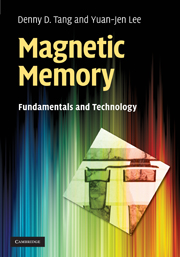Book contents
- Frontmatter
- Contents
- Preface
- Acknowledgments
- 1 Basic electromagnetism
- 2 Magnetic films
- 3 Properties of patterned ferromagnetic films
- 4 Magnetoresistance effects
- 5 Field-write mode MRAMs
- 6 Spin-torque-transfer mode MRAM
- 7 Applications of MTJ-based technology
- Appendix A Unit conversion table for cgs and SI units
- Appendix B Dimensions of units of magnetism
- Appendix C Physical constants
- Appendix D Gaussian distribution and quantile plots
- Appendix E Weibull distribution
- Appendix F Time-dependent dielectric breakdown (TDDB) of magnetic tunnel junction devices
- Appendix G Binomial distribution and Poisson distribution
- Appendix H Defect density and the breakdown/TMR distribution of MTJ devices
- Appendix I Fe, Ni and Co material parameters
- Appendix J Soft error, hard fail and design margin
- Index
- References
5 - Field-write mode MRAMs
Published online by Cambridge University Press: 06 July 2010
- Frontmatter
- Contents
- Preface
- Acknowledgments
- 1 Basic electromagnetism
- 2 Magnetic films
- 3 Properties of patterned ferromagnetic films
- 4 Magnetoresistance effects
- 5 Field-write mode MRAMs
- 6 Spin-torque-transfer mode MRAM
- 7 Applications of MTJ-based technology
- Appendix A Unit conversion table for cgs and SI units
- Appendix B Dimensions of units of magnetism
- Appendix C Physical constants
- Appendix D Gaussian distribution and quantile plots
- Appendix E Weibull distribution
- Appendix F Time-dependent dielectric breakdown (TDDB) of magnetic tunnel junction devices
- Appendix G Binomial distribution and Poisson distribution
- Appendix H Defect density and the breakdown/TMR distribution of MTJ devices
- Appendix I Fe, Ni and Co material parameters
- Appendix J Soft error, hard fail and design margin
- Index
- References
Summary
Introduction
Magnetic ferrite core memory was invented and produced in the 1960s, prior to semiconductor memory. Ferrite cores are made from a paste of ferrite powers, which are sintered at high temperature. The process of forming a discrete core is not as scalable as the integrated circuit process on a silicon wafer. The product life of a magnetic core was short, and in the 1970s this technique was replaced by semiconductor memory. A similar fate happened to magnetic bubble memory, another type of magnetic memory, which was built on a magnetic garnet material substrate (gadolinium gallium garnet, Gd3Ga2(GaO4)3). The bit density of bubble memory technology is scalable since it is made with a planar process, similar to the silicon integration circuits. However, because it is on garnet, it is passive and cannot perform logic functions (such as address decoding), and it requires a companion silicon chip to provide the logic function to complete the memory access function. Even with better memory performance, magnetic bubble memory could not compete against magnetic hard disk and semiconductor memory, which continue to show a clear path of scaling for a lower cost. By the mid 1980s, commercial magnetic bubble production had ended.
Subsequent efforts in the development of magnetic memory have been focused on the integration of magnetic thin-film memory devices into silicon wafer processes. Magnetic memory devices exist in the form of thin-film stacks, which can easily be integrated into the back-end metal wiring metallurgy process.
- Type
- Chapter
- Information
- Magnetic MemoryFundamentals and Technology, pp. 91 - 121Publisher: Cambridge University PressPrint publication year: 2010

